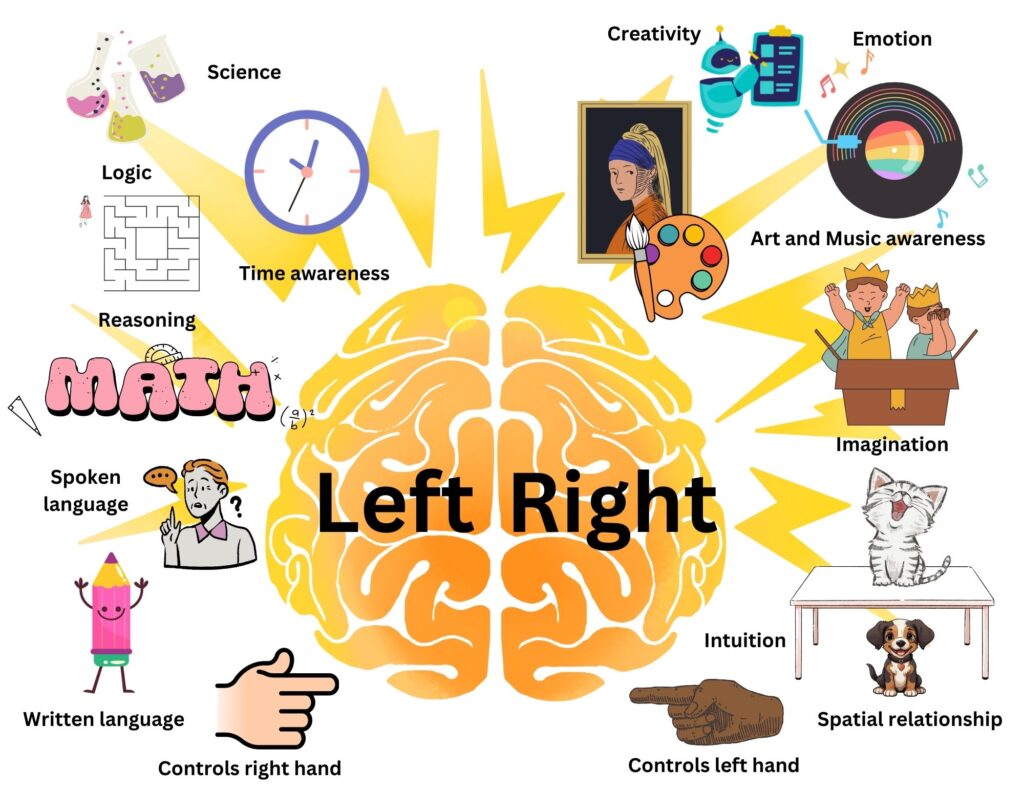Learning about the brain
The brain is one of our vital organs and a key component of the central nervous system. It serves as the control center for our body, receiving signals, processing information, and responding to sensory input. Similar to how a baby floats in the mother’s womb, the brain is cushioned and protected by a clear fluid inside the skull.
To better understand the brain’s structure and function, we decided to create a model using Crayola sculpting clay. We had fun shaping the clay into long sausages and molding them into the left and right hemispheres of the brain.

Parts of the brain
We learned that there are three main parts of the brain:
- The cerebrum: It’s the largest part and helps us think and solve problems.
- The cerebellum: It’s at the back of the brain and helps with balance and coordination.
- The brainstem: It’s at the base of the brain and controls things like breathing and heart rate.
Cerebrum means “Brain” and Cerebellum means “Little brain” in Latin.

These are big words for a 5-year-old to remember. I wanted to keep it simple, especially since I didn’t want to overload my daughter with lots of terminology about the brain structure. So, I decided to simplify them and make picture rebuses so it would be easier for her to remember these words.



Then we learned that the brain is divided into two hemispheres. The left side controls the right side of the body, and the right side controls the left side of the body. The crossover of nerves from each side to the other happens in the lower portion of the brain stem.
To learn about the different tasks that the left and right sides of the brain do, my daughter and I sat in front of a computer and used a free version of an online graphic design tool. It was fun to pick out all the different images to illustrate various brain functions.

Brain Circuit Model
Eventually we built a brain model that illustrates the mapping between areas of the brain and body functions. Wires at the back of the model represent the nervous system, carrying signals to the brain. The red lamp on the top lights up when the red and black wires are correctly mapped to the corresponding brain parts and functions.
- Frontal lobe: Thinking, Speech and Movement
- Temporal Lobe: Hearing and Smell (Olfactory cortex)
- Parietal Lobe: Taste and Touch.
- Hypothalamus: Hunger and Thirst
- Occipital Lobe: Sight
- Cerebellum: Balancing and Muscle Control
- Brain Stem: Sleep, Heart Rate and Breathing
I didn’t expect my daughter to remember the names of the lobes at this point, as well as the word hypothalamus, but it will be useful for our future lessons. We might as well do a Brain Hat like this one on YouTube. I also found this hilarious brain hat on Amazon 🙂
Taking care of the brain
- The brain is very delicate, and we need to protect it by wearing a helmet when riding a bike or scooter.
- Eating a balanced diet gives the brain the nutrients it needs to stay sharp and focused.
- Exercise helps to improve focus, memory, academic performance, and processing speed.
- Lack of sleep can cause thinking and memory problems.
- Keep your brain sharp by challenging it with puzzles, games, or reading a book.
- Sing and listen to music. According to a Harvard article, music activates ‘some of the broadest and most diverse networks of the brain.’ This can also improve mood, and upbeat music can increase energy.
- Laugh a lot 🙂 Laughter increases the production of endorphins in the brain. Laughing also improves blood flow and circulation.
Please see the link to the “The Nervous System” activity book which I created for our lessons about the brain and the nervous system.